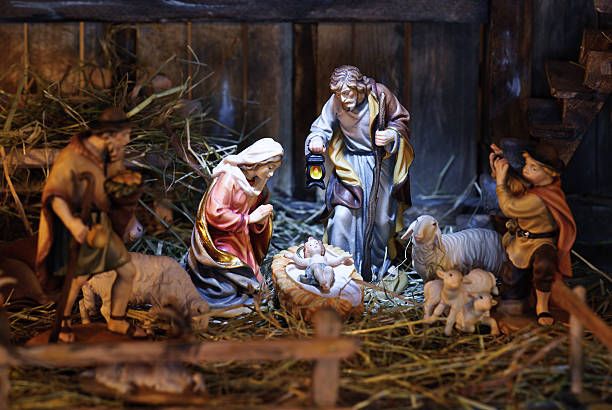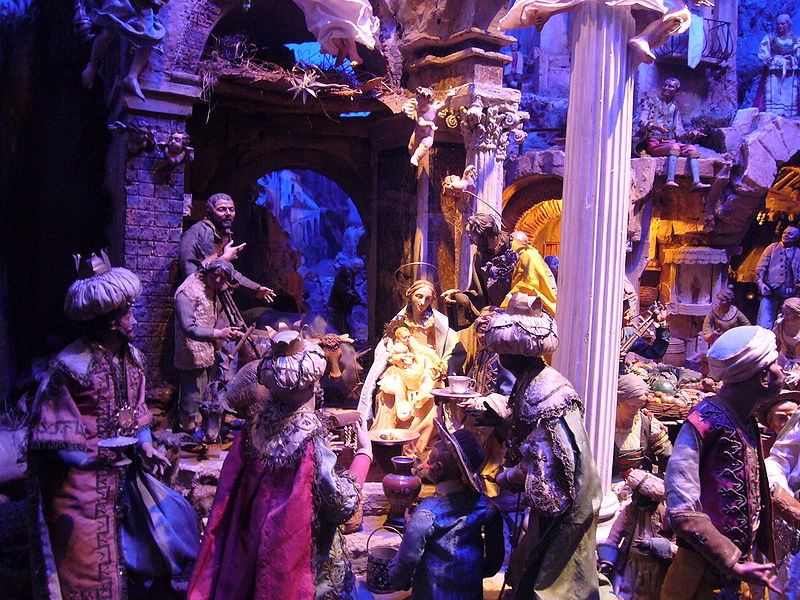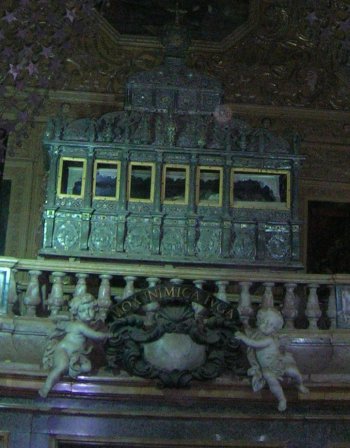Sunday, December 27, 2009
Baby Jesus and Baby St John the Baptist
Saturday, December 26, 2009
Friday, December 25, 2009
Merry Christmas 2009
Please feel free to copy this onto your blogs and pass it on.
A special thanks to Stathis as well for encouraging me to use my creative talents for a Higher good.
Thursday, December 24, 2009
Christmas Crib in and Indian House

This is typically what a Christmas Crib would look like in an Indian house or a housing colony. Note to all Canadians and USA people, India is a country which is 80% hindu, yet Catholics can put up Christmas decorations and cribs. Why is it that Canada and USA which have more Catholics and Christians are not allowed to put up Nativity scenes on front lawns? Time for some self examination
Wednesday, December 23, 2009
No Christmas trees in India
Christmas midnight mass in India
You see India is not as tolerant about religious minorities as it used to be when I was a little kid. As a teen it was very common to see lots of police outside Church at the Christmas Midnight mass this was done as a two fold reason, on the one hand it was to protect Catholics from attacks from the religious majority. It was also done to intimidate Catholics and make us feel like outsiders in our own country.
Christmas in India
 In India during Christmas, Catholics put up a big star outside their houses, or if the apartment building is full of Catholics then a big star like the one above is put up. This star reminds us about the Star that led the Wise men to our Lord Jesus Christ. I miss seeing such stars outside Catholic homes in Canada.
In India during Christmas, Catholics put up a big star outside their houses, or if the apartment building is full of Catholics then a big star like the one above is put up. This star reminds us about the Star that led the Wise men to our Lord Jesus Christ. I miss seeing such stars outside Catholic homes in Canada.
Tuesday, December 22, 2009
Monday, December 21, 2009
Sunday, December 20, 2009
Saturday, December 19, 2009
BL. Pope Urban V - 19th December 2009

Friday, December 18, 2009
Ven Delia Tetreault - 18th December 2009
Thursday, December 17, 2009
St. Lazarus - 17th December 2009
Wednesday, December 16, 2009
Advent Poem - St. John of the Cross
St. Adelaide - 16th December 2009
Tuesday, December 15, 2009
Update on Communion situation in Toronto in realtion to swin Flu
December 15, 2009
Ongoing Communication regarding the H1N1 Flu Virus
To all clergy and employees of the Archdiocese of Toronto,
I would like to provide a further update regarding our H1N1 planning. In my communication of November 2, I outlined a series of temporary measures that were implemented after consultation with local health experts, church officials, and others with extensive experience in pandemic planning.
In recent days, we have seen the number of cases of H1N1 decrease significantly. While we are relieved that the virus appears to have peaked, we must remain vigilant in maintaining good hygiene practices, especially during the winter months and traditional flu season. Over the last several weeks, all Ontarians have been provided the opportunity to receive vaccination against the H1N1 virus, in addition to the traditional flu shot offered at this time of year.
I would encourage parishes to continue the following pro-active measures:
· Provide hand cleaning stations near church entrances.
· Ask all those distributing communion to wash their hands before mass. You may wish to provide an alcohol-based sanitizer so that all ministers may sanitize their hands before and after distributing communion.
· Kindly remind your parishioners that if they are feeling sick or ill, it is best for them to stay home.
In terms of our liturgical practices, effective Wednesday, December 16, I am removing the temporary restrictions that I imposed in the communication of November 2.
Although it was not mentioned in that communication, I encourage parishes to provide the faithful with Holy Water in the fonts at the entrances to the church.
As in the past and to ensure consistency in our churches, please communicate these changes to your parishioners. This update will also be available on our website and through our H1N1 page: www.archtoronto.org/flu.
To our family of faith, I extend my gratitude for your patience over the last number of weeks. As we await the birth of the Christ child, we are ever mindful of our call to serve the most vulnerable among us just as Christ cares for each member of his family.
Sincerely in Christ,
Thomas Collins
Archbishop of Toronto
Venerable Bishop Vital Grandin - 15th December 2009
Monday, December 14, 2009
Recognising the mystery hidden within Christ Jesus
Sacred Heart Santacruz
St. John of the Cross - 14th December 2009
Sunday, December 13, 2009
The Lord Jesus Christ- God's Final Word - St John of the Cross
Gaudette Sunday 13th December 2009
Sunday, December 6, 2009
St. Nicholas - 6th December 2009
Saturday, December 5, 2009
St. Sabas - 5th December 2009
Friday, December 4, 2009
Marian Prayer of St. John Damascene
I miss Christmas as it was
I feel empty on Christmas day its like a holiday but not Christmas. While back home we would all wonder what a white Christmas would be like, here where I have a white Christmas I dont feel like it is Christmas.
Back home we would chop down a branch of a tree, let it dry so the leave would fall and then wrap up the tree in cotton so that it would look like the branch of the tree was covere with snow we would then decorate the snow covered tree. Here we have snow and real conifer trees and yet I dont feel like its Christmas.
I dont know the failing I will admit is mine.
I do have a special treat for all of you who read my blog as we come to the last week of advent.
St. John Damascene - 4th December 2009
Thursday, December 3, 2009
Basilica of Bom Jesus - Goa India
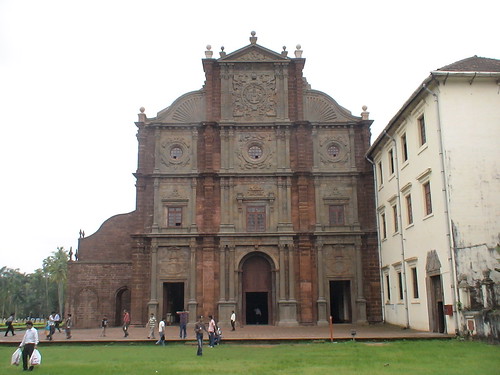
Old Goa, built in 1605, and now declared a World Heritage Monument. The church houses the sacred relics of St. Francis Xavier, patron saint of Goa, who died while on a sea voyage to China on December 2,1552. The following year, while transferring his remains to Goa, in accordance with his wishes, it was found that the saint's body was as fresh as the day it was buried. This miraculous phenomenon continues to attract the devout of all lands and an Exposition or public viewing of his body every ten years attracts lakhs of pilgrims. During the 450 years of Portuguese rule in Goa, St. Francis Xavier was believed to have afforded protection to the rulers who handed over their symbols of office to the saint during every changeover of the office of Governor General. The Saint had miraculous healing powers, which were experienced by the erstwhile Nizam of Hyderabad when he came for the Exposition of 1878.
St. Francis Xavier - 3rd December 2009

Not many of my readers know this but St. Francis Xavier is one of my favourite saints. He is buried in India in Goa which is where my ancestors come from. In addition to this, I did my university studies at St. Xavier's in Bombay which was run by the Jesuits. Thus I am very fond of St. Francis Xavier.
Wednesday, December 2, 2009
Blessed Rafal Chylinski - 2nd December 2009
Tuesday, December 1, 2009
Advent reflections for Week 1
Prayer to the Holy Name of Jesus
St John Of Vercelli - 1st December 2009
Monday, November 30, 2009
Prayer to St. Andrew the Apostle
Saturday, November 28, 2009
The Miraculous Medal
The front side of the Medal: messages and symbolism
On the front side of the medal we see the Blessed Virgin Mary as the Victorious Woman of Genesis. God Himself put enmities between the Woman and the serpent, a battle to be carried on "in that ‘monumental struggle against the powers of darkness’ which continues throughout human history." (Mother of the Redeemer, #47, p.67; Pope John Paul II; March 25, 1987)
On the medal we see Mary Immaculate with her foot crushing the head of the serpent. "She who as the one ‘Full of Grace’ was brought into the Mystery of Christ in order to be His Mother and thus the Holy Mother of God . . . remains in that mystery as ‘the Woman’ spoken of by the Book of Genesis (3:15) at the beginning . . . " (Mother of the Redeemer, #24, p.23; Pope John Paul II; March 25, 1987). In many other official documents of the Church and writings of Saints we find Mary referred to as this Victorious Woman of Genesis destined to crush the proud head of the devil.
"The Bible is replete with the mystery of the Savior, and from Genesis to the Book of Revelation, also contains clear references to her who was the Mother and Associate of the Savior." (Marialis Cultus, #30, p.28; Pope Paul VI; Feb.2, 1974).
The year 1830 was shown inscribed on the globe at the base of the Medal, so it is clearly meant to convey some message. It can very well indicate the year which begins the final stages of the battle between the Woman and the serpent, between good and evil. It could be Heaven’s way of indicated the year opening the Marian Era.
Our Lady is standing on the globe of the world. Catherine could distinguish France in particular. In this we can see Mary both as the Victorious Woman and as the Queen of Heaven and Earth.
Mary’s hands are shown showering a cascade of brilliant rays on the world, as if she found them too heavy with graces and was eager to pour them on us. We can see her as our "Advocate, Auxiliatrix, Adjutrix and Mediatrix. Of this intercession of hers for the People of God with the Son, the Church has been persuaded ever since the first centuries . . . " (The Great Sign, Part I, p.4; Pope Paul VI; May 13, 1967).
Around the oval frame of the medal we read the words, "O Mary, conceived without sin, pray for us who have recourse to you." In this brief prayer we find the truth of (a) the Immaculate Conception of Mary, and (b) Mary’s intercessory power with God for us who ask for her aid.
The reverse side of the Medal
On the reverse side of the Medal we see a Cross, the symbol of Christ’s Redeeming Sacrifice on Mount Calvary for the salvation of the world.
At the base of the Cross is a bar, which symbolizes the foot of the Cross. Intertwined with the bar is the letter "M" symbolizing the Mary’s intimate involvement at the foot of the Cross with her Son’s Redemptive Sacrifice. We see the "M" is below the line or foot of the Cross, signifying Mary’s subordinate role to that of Jesus. "This union of the Mother and her Son in the work of Redemption (cf. Lumen Gentium, #57) reaches its climax on Calvary, where Christ ‘offered Himself as the perfect Sacrifice to God’ (Hebrew 9:14), and where Mary stood by the Cross (cf. John 19:25), ‘suffering grievously with her only-begotten Son. There she united herself with a maternal Heart to His Sacrifice, and lovingly consented to the immolation of this Victim which she herself had brought forth’ (II Vatican Council, Dogmatic Constitution on the Church Lumen Gentium, #58), and also was offering to the Eternal Father." (Marialis Cultus, #20, p.19, Pope Paul VI, Feb.2, 1974)
It was also at the foot of the Cross that Jesus gave us, in the person of the Beloved Disciple, His own Mother to be our Mother. "Woman, behold your son; son, behold your Mother" (John 19, 25-27). And the beloved disciple gives us an example to follow, so that we learn to take Mary into our homes, into our lives, into our hearts, as do loving children.
So the "M" stands not only for Mary, but also for Mother. "The new Motherhood of Mary, generated by faith, is the fruit of the ‘new’ love which came to definite maturity in her at the foot of the Cross, through her sharing in the Redemptive Love of her Son. Thus we find ourselves at the very center of the fulfilment of the promise contained in the Proto-gospel . . . (Gen. 3:15)" (Mother of the Redeemer, #23-24; p.33; Pope John Paul II; March 25, 1987). "Mary’s mediation is intimately linked with her Motherhood." (ib. #39; p.54)
Since the Cross is the symbol of Christ’s Redemptive Sacrifice, we can also see a Eucharistic symbolism on the Medal. "To perpetuate down the centuries the Sacrifice of the Cross, the Divine Savior instituted the Eucharistic Sacrifice [the Mass], the Memorial of His Death and Resurrection, and entrusted it to His Spouse the Church" (cf. II Vatican Council, Sacrosanctum Concilium, #47), which the Church continues to do "in union with the Saints in Heaven, and in particular with the Blessed Virgin." (Marialis Cultus, #20, p.19-20; Pope Paul VI; Feb. 2, 1974). In every Eucharistic Liturgy the Church involves the Blessed Virgin Mary, so befitting to her who stood heroically at the foot of the Cross uniting her sufferings to the Sacrifice of her Son, filling up in her body those things that are wanting to the sufferings of Christ, for the sake of His Mystical Body, the Church. (cf. Col. 1:24). In all of the approved apparitions of Our Lady there is a Eucharistic thrust. She usually asked for a church to be built, in which the Eucharistic Sacrifice and the Blessed Sacrament always have prime place. Mary always leads us to Jesus, and Jesus is especially present in the Eucharist.
On the Medal beneath the Cross and the "M" we see the two Hearts, the Sacred Heart of Jesus encircled with a crown of thorns, and the Immaculate Heart of Mary pierced with a sword. We see the prophesy of Holy Simeon fulfilled: the Son who was destined for the sign of contradiction, dying on the Cross, and the Mother pierced with a sword of sorrow beneath the Cross "so that the thoughts of many hearts may be revealed" (Luke 2, 34-35). The union of the two Hearts foreshadows the message of Fatima: "The Sacred Heart of Jesus wants the Immaculate Heart of Mary to be venerated at His side." (Lucia Speaks, III Memoir, World Apostolate of Fatima, Washington, NJ: 1976; p.137). "God wishes to establish in the world devotion to my Immaculate Heart." (ib. p.126)
The two Hearts are surmounted by flames, symbolizing the burning love with which Jesus and Mary accomplished the work of Redemption, each in their proper way. No greater love does one have than to lay down one’s life. (cf. John 15:13). "Christ loved the Church and gave Himself up for her . . . " (Ephesus 5:25-27)
Around the oval frame of the Medal, encircling the Cross, the "M," and the two Hearts, we see a crown of twelve stars. This can be seen as a reference to the "the Great Sign" in the Book of Revelation/Apocalypse; the "Woman clothed with the sun, with the moon beneath her feet, and on her head a crown of twelve stars." The Woman engaged in battle with the "huge red Dragon . . . the ancient serpent, who is called the devil, or Satan" (Rev./Apoc. 12:3 & 9) is the Queen of the Apostles, the Mother of the Church. "The enmity, foretold at the beginning, is confirmed in the Apocalypse (the book of the final events of the Church and the world), in which there recurs the sign of the ‘Woman,’ this time ‘clothed with the sun’ (Rev. 12:1). Mary, Mother of the Incarnate Word, is placed at the very center of that enmity, that struggle which accompanies the history of humanity on earth and the history of Salvation itself." (Mother of the Redeemer, #11; p.16; Pope Johne Paul II, March 25, 1987)
We can see then in the Miraculous Medal a symbol of the whole history of salvation from Genesis to Apocalypse, and we can see the vital role that the Victorious Woman is destined in the final defeat of the devil. It is amazing how in such a small medal God can give us so many profound lessons. As is the case with all of God’s graces, it is up to us to humbly accept what He offers, as Mary did (cf. Luke 1:38), and to cherish and ponder it in our hearts, as Mary did. (cf. Luke 2:19 & 51)
(Courtesy Here)
St. Catherine Labouré - 28th November 2009
Biographical selection:
Zoé Labouré, the future Catherine, was born on May 2, 1806 , the ninth of eleven children born to a farm family in Fain-les-Moutiers, Côte d’Or, France. She never learned to read or write. At age 8, her mother died and she was put in charge of running the house and helping her father. Her father allowed her at age 22 to enter the convent of the Daughters of Charity of St. Vincent of Paul.
In religion she took the name of Catherine and was sent to the convent at Rue du Bac, Paris. At half past 11 o’clock on the night of July 18, 1830, she was awakened by the vision of a child who led her to the chapel where Our Lady spoke to her for more than two hours. She told Catherine that God wished to charge her with a mission.
On November 27 of that same year, Our Lady appeared to her a second time in the chapel. She held a globe in her hands upon which the word France was written. Our Lady told St. Catherine that it represented the entire world, but that she wanted to help France in particular.
Then, the vision changed and she saw Our Lady standing on a globe crushing the serpent under her feet, with rays of light streaming from her hands. These words in French surrounded the vision: “O Mary conceived without sin, Pray for us who have recourse to thee.” Then Catherine saw another picture with a capital M with a cross above it, and below it, two hearts, one thorn-crowned and the other pierced with a sword. The Virgin spoke, this time giving a direct order: "Have a medal struck as I have shown you. All who wear it will receive great graces."

She told only her confessor Fr. Father Jean Marie Aladel about these visions, and at first he did not believe her. No one but he and the Archbishop of Paris knew that it was she who received the revelations. In 1832 the first medals were issued and many miracles were worked because of them. In a few years the fame of the Miraculous Medal of Our Lady spread all over France and Europe.
In 1842 the Jew Alphonse Ratisbonne was visiting Rome. He was wearing the medal when he received a vision of Our Lady in the Church of St. Andrea delle Frate in Rome. This was the cause of his conversion, and later he founded the Congregation of the Sisters of Sion for the conversion of the Jews. This incident contributed significantly to the dissemination of the Miraculous Medal.
In the convent where St. Catherine lived, not even the Superior Mother knew who had received the revelations. St. Catherine was transferred to the convent of Enghien-Reuilly and lived there for over 40 years unknown, carrying out the humble functions as gate-keeper, head of the poultry yard, and caring for the aged in the convent’s hospice. Only eight months before her death did she receive permission from her confessor to reveal to her Superior, Mother Dufès, that she was the one who had received the apparitions of Our Lady. She died on December 31, 1876. Soon after her funeral miracles were worked through her intercession.
When her body was exhumed in 1933 it was found completely fresh and supple. Her incorrupt body is encased in glass beneath the side altar at 140 Rue du Bac, Paris, beneath one of the spots where our Lady appeared to her.
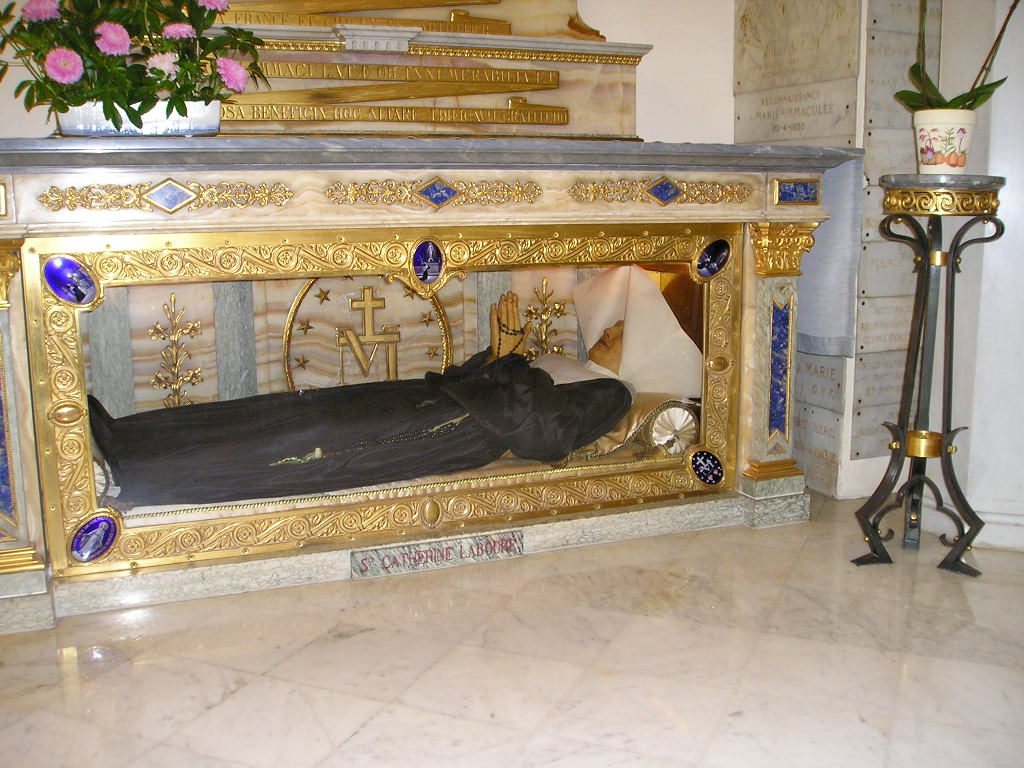
Comments of Prof. Plinio:
Given the extraordinary diffusion of the Miraculous Medal, I think we can say that St. Catherine Labouré was the woman who played the greatest role in History in spreading devotion to Our Lady. The greatest man was St. Louis Grignion de Monfort. However, their lives and how they spread Marian devotion were profoundly different.
St. Louis de Montfort was a founder of two religious Congregations, a missionary, a pilgrim walking from one place to another, fighting, preaching, writing books, being attacked and counter-attacking in his turn. Therefore, he was constantly appearing in public in those few French provinces where he was allowed to preach by the Jansenist Bishops who had infiltrated the Catholic Church in France at that time. In those places his public example of virtue and continuous preaching about Our Lady caused his life and devotion to make a mark on History. His name appears wherever one speaks of true devotion to Our Lady.
The life of St. Catherine Labouré was the exact opposite. She was so unknown, so humble, so useless that the very sisters of her order did not know it was she who had received those revelations. Even her religious Superiors were unaware of this. They knew that some sister of their order had received revelations from Our Lady, but they did not know which one it was. Notwithstanding, she was the cause of an enormous diffusion of devotion to Our Lady. Our Lady wanted this devotion of the Miraculous Medal to be spread through St. Catherine, but in opposition to the life of St. Louis de Montfort, St. Catherine remained completely unknown.
She was also different from St. Bernadette Soubirous since everyone knew that St. Bernadette was the one who had seen Our Lady. St. Catherine’s vocation was only to report the revelations and the order for the medal to be struck. The miracles that immediately began to take place did all the rest.
There are many other comments that could be made about the different ways God acts in accordance with the various psychologies of His saints. But here I want to highlight only one general facet of the life of St. Catherine.
Let me point out that it is appropriate for a woman to live in obscurity when she enters a religious order. When she lives in the world, it is appropriate for her to remain within the limits of the family. Normally women do not have a public mission to fulfill. It is an exception to the rule when women are known in the Church for the public missions they exercised during their lives. Even when Divine Providence wants to use them for a mission of great relevance, they generally continue to live in the seclusion of their convents, away from the eyes of the public.
This is in accordance with the moral characteristics of a woman, with her role in the general plan of creation. In the life of St. Catherine Labouré, which is permeated with the supernatural in the accomplishment of a sublime mission, God was faithful to the general rule He established. He kept her in obscurity.
This leads us to see how mistaken modern civilization is in pushing women to have a public life either in the civil or religious sphere, entrusting them with tasks that normally should be given to men. What the Revolution presents as the emancipation of women is actually to enslave them to many kinds of work that are not according to their nature.
St. Catherine Labouré shows us the healthy characteristics of a woman. Being reserved and living in the obscurity of her religious order, she accomplished a work incomparably superior to that of I don’t know how many social leaders, business women and public representatives in Congress. God wanted her to remain entirely feminine, because to each sex God has a plan proper to its nature.
As counter-revolutionaries, we must highlight such aspects in the lives of the saints. Otherwise, we remain in the realm of common pious and respectable comments that do not prevent the Revolution from going forward. We must show the counter-revolutionary aspects of the Saints; otherwise we do not accomplish the mission Divine Providence gave us.
Friday, November 27, 2009
Having Faith when some one is sick
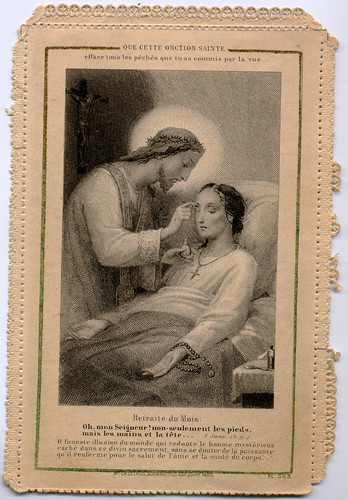
For me one of the toughest times to have faith that God is in charge is when some one I care for is sick. I think this goes back to when I was a kid and my grandma was in hospital in intensive care. It was my birthday and I went to see her. I don't remember what birthday it was, what I do remember is a my nana lying on this bed connected to all sorts of machines one of them was a kind of a canister with water in it and a solitary bubble in it (some of my nurse friends care to explain to me what this was.) and the bracelet my mum made me wear that day. Soon after nana passed away. Since then I cannot bear hospitals. They smell anitiseptic and in my mind people who go there die. I rarely go to hospitals or doctors when anyone is sick and least of all when I am ill.
I cannot bear to see people who I love for sick, this is becasue there is nothing I can do for them, I am not in control of the situation. It is difficult for me to see the hand of God in such situations becasue my faith is obviusly not at that level. It is hard to watch a person struggle with a debilitating disease knowing that they may well not make it. I guess for me the lesson is to learn to see God's hand in such situations.








